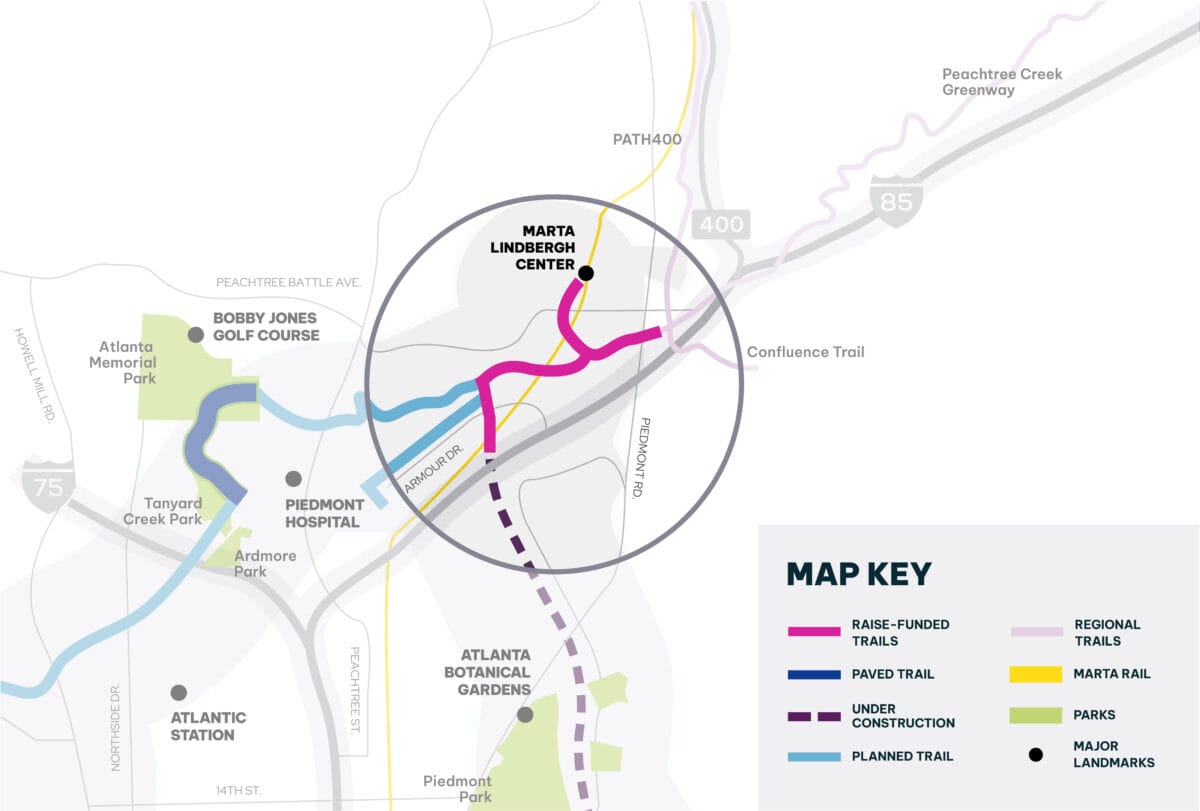
The U.S. Department of Transportation awarded a $25 million grant to the Atlanta Beltline that includes funding for connections to PATH400 in Lindbergh. The City of Atlanta and Atlanta Beltine Inc. received the Rebuilding American Infrastructure with Sustainability and Equity (RAISE) grant for construction of multi-use trails between the Armour/Ottley and Lindbergh areas.
This new section of the Beltline marks several important connections for the Beltine and PATH400, including the Beltline’s first direct connection to a MARTA transit station. 2.2 miles of trails will connect the Atlanta Beltline to the southern end of PATH400 where it meets the Confluence Trail and the Peachtree Creek Greenway south of Lindbergh Drive. The additional spur connecting to the Lindbergh Center MARTA station is a big step for Atlanta’s multi-use path system, fulfilling one of the original goals of the Atlanta Beltline project.

Most of the Atlanta Beltine trails follow abandoned railroad lines, but not this upcoming connection. Routing the trail among interstate and local roads, MARTA and freight rail, and several regional trails makes the new sections, known as Northeast Trail Segment 3 and Connectors 1 & 2, among the most complex to design and build. Construction of Section 3 is scheduled to begin in 2025.
“The Northeast segment of the BeltLine is a huge undertaking, but Atlanta does big and we do it well—and we do it together,” said Atlanta Mayor Andre Dickens. “Thanks to Senator Ossoff, Senator Warnock, Congresswoman Williams and the Biden Administration, Atlanta now has $25 million in funding—in addition to millions in infrastructure dollars already delivered—for utility, storm water, accessibility and safety infrastructure for Segment 3 and surrounding connectors.”
22 projects around the country were selected for the RAISE grant, with a maximum $25 million award for projects costing less that $45 million. Transportation Secretary Pete Buttigieg noted that all of the projects were planned and proposed by local organizations. He said. “We don’t design the projects at headquarters. We are proceeding very much on the idea that the answers don’t all come from Washington, but more of the funding should.”
Senators Jon Ossof and Raphael Warnock were pleased to secure funding for the project, and each touted the importance of connecting Atlanta’s regional trail network.
“The BeltLine is more than a walking path, it is an artery connecting Atlantans to each other and their neighborhoods in the heart of our state,” said Sen. Reverend Warnock. “That is why I am proud to have worked alongside Senator Ossoff to secure these funds for the city to expand trail construction, bolster accessibility, strengthen economic development and more. Atlanta is on the frontlines of our green economy, and by investing in this world-class transportation corridor, we are continuing to pave a path towards a better tomorrow.”
“The BeltLine is a transformative Metro Atlanta infrastructure project to upgrade quality of life and spur equitable development across the region. Through the Bipartisan Infrastructure Law, we are investing to accelerate the completion of the BeltLine Trail,” Sen. Ossoff said. “Imagine families walking and biking, restaurants, retail, and small businesses, green spaces and trail connectivity across Metro Atlanta. This is a huge step forward towards that vision.”
“With the incredible support of the USDOT and our congressional delegation, we’re creating a city that allows people to move within it, creating new access points that lead to jobs, housing, and activities,” said Clyde Higgs, President and CEO of Atlanta BeltLine, Inc. “The BeltLine is creating a vibrant public space and a more equitable city for Atlantans by ensuring mobility and access for all who live and work near the corridor. The construction of the Northeast Trail network is a crucial part of this vision.”
The expansion of PATH400 north toward Sandy Springs and south to the Atlanta Beltline and MARTA Lindbergh Center will connect Buckhead with the rest of the city in new and exciting ways. $25 million from the RAISE grant will fill the funding gap and make this important southern connection possible.